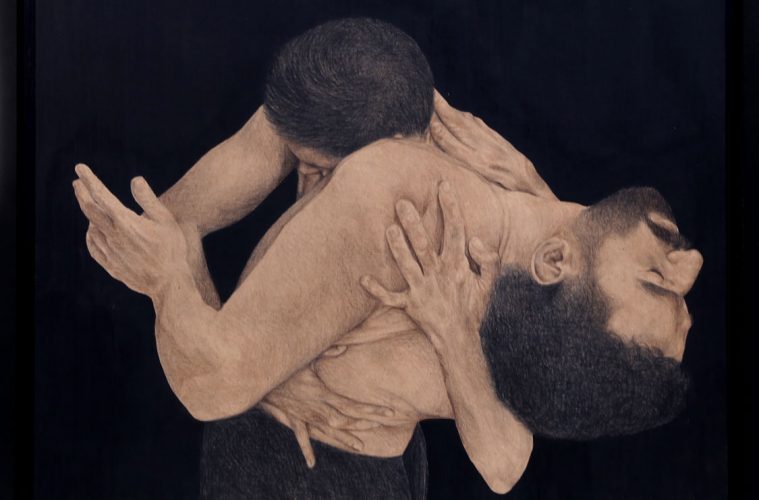By Lizzy Vartanian Collier
Iranian artist Alireza Shojaian is crying as he hugs a familiar figure goodbye at the entrance of the transit hall. This is not the first farewell. This is just the last in a long list of friends leaving Iran in order to live their own lives without hiding their true identity.
The airport is not the only place for separations in Iran. On 28 February 2016, one year after their airport goodbye, Shojaian received the news that his friend had committed suicide. As an artist, Shojaian wanted to use his work to do something for the suffering that he and others had been subjected to while living under a regime that would not allow them to reveal their sexuality. Unable to exhibit his work in open dialogue with the people in Iran, he decided to leave the country.
Shojaian believed Beirut was the answer. He emailed many galleries, there, to see if they would represent his work, but no one replied. By a stroke of luck, his professor – one of the few people in Tehran who knew about the identity he was hiding – found Antoine Haddad, the owner of ARTLAB Gallery in Beirut. Shojaian showed Haddad his work in-person when he was traveling to Tehran, work that he had quite literally been hiding in his closet since 2012. “Don’t leave anything behind,” Haddad said, “Bring them all, I will hold a solo show for you.” Thus began the artist’s career in Beirut, represented by Haddad’s gallery.
Homosexuality is a prevalent theme in Shojaian’s portfolio. The paintings and drawings are covered in nude male bodies that fight and embrace one another. “Whatever I create belongs to real stories, and mostly my personal life,” explained Shojaian. “I believe our society refuses whatever they find too erotic, so I always try to show the other side of this identity, the part which is mutual between all of us as human beings.” The images show intimate relationships that are no different to those between a man and a woman, except that the lovers in Shojaian’s images are men. The bodies are entwined, moving together as one, and sometimes it even looks like the figures are dancing. “A choreographer has to try to deliver a story with the forms of the body,” added Shojaian. “It’s almost the same as choosing a position for the figure to deliver the emotions through a figurative artwork.”
The main image in Shojain’s main image of his recent ARTLAB exhibition, Sweet Blasphemy (1 – 24 February 2018), consisted of a partially nude male figure lying on a white blanket. He looks like he might be dead at first glance, but one might prefer to think he is sleeping. In addition to the figure on the white sheet, Shojaian prepared eight additional drawings. In some of the works, the male figure – all of whom are the Lebanese artist Mo Khansa – is seen caressing leaves. In two works, the leaves lie on the white sheet, dying.
Shojaian said that,“That exhibition was the result of meeting another soul. This meeting led me to a love, but I had to kill it, so the exhibition was a funeral for that love.” The story of Rumi and Shams was the central to the artist’s exhibition of dying love, and the exhibit’s title being taken from Turkish writer Elif Shafak’s novel The Forty Rules of Love, which tells the same story. Much of the poetry of world-renowned Persian poet, Jalal ad-Din Muhammad Rumi, resulted from the love between himself and Shams-i-Tabrizi. After years living together in the Turkish city of Konya, Shams left Rumi, who then dedicated his writings to his departed lover. Some believe that Rumi’s followers, jealous of his relationship with Shams, were responsible for Shams’s death.
During the opening, Khansa lay on a table covered in a white sheet for three hours, mirroring Shojaian’s artwork. Requiem music was playing and church incense were burning through the gallery to activate all of the audience’s senses. Shojaian reflected, “I was trying to invite the audience to stand next to me and see a different layer of the art, from the beauty that I see in the live model to the final result, the art piece itself.”
Sweet Blasphemy was Shojaian’s biggest success thus far in Lebanon. He received many messages about the exhibition, even before its opening, and the show sold out. Despite the sharp differences between the art scenes in Beirut and Tehran, Shojaian’s career in Lebanon is doing well. He explained that the censorship in Iran means that the art produced there is interesting, but never direct. “If you’re trying to project any commentary on society in Tehran, there is an issue. In Beirut, there is a stronger connection between the artist and the rest of the world.” Yet, while there is more freedom in Lebanon, there are still issues for queer artists. When explaining why he depicts queer identities in his work, Shojaian explained that, “I want to be effective in society. We have this need in the Middle East, more than anywhere else. Beirut is the fastest growing place in the whole region in this case.”

